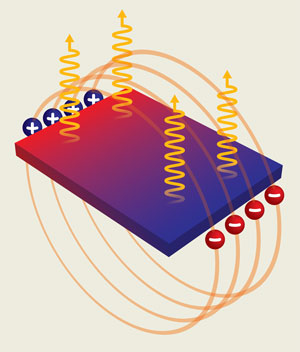
We precisely control the energy levels, interstate transition rate, luminescence efficiency, spin multiplicity etc. of organic/inorganic semiconductors and nanoparticles by their dynamic and static molecular structure, shape/size, chemical composition, and assembly pattern, for creating innovative energy-related technologies.
Luminescence and Excited States of the Molecules with Double Excitation Character
In molecular excited states, the energy level of S1 is higher than that of T1, because of the exchange energy of two electrons in the excited state derived from the Fermionic nature of electrons and the Pauli exclusion principle. Cyclazine and heptazine derivative have been reported to have un-overlapped HOMO and LUMO and to possibly show negative ΔEST (E(S1) – E(T1)) (Leupin et al., JACS 1980; Ehrmaier et al., J. Phys. Chem. A 2019). We designed and synthesized the substituted heptazine molecule and experimentally proved its negative ΔEST of –11 meV by the temperature dependence of delayed fluorescence and transient absorption. Conventional DFT quantum chemical calculation with one-electron description gave the positive ΔEST, while wavefunction-based quantum chemical calculation gave the negative ΔEST, indicating the double excitation character of the molecule. The reverse intersystem crossing rate was faster than the intersystem crossing rate, and much shorter delayed fluorescence and transient EL lifetime were exhibited. These results are the demonstration of unique luminescence from the molecule with inverted S1 and T1 derived from double excitation character in the excited state.

Molecules showing the inverted singlet and triplet excited state and energy diagram
Simple cubic self-assembly of colloidal quantum dots
Colloidal quantum dots (QDs) have attracted substantial attention due to their characteristic optoelectronic properties based on their size confinement effects. They are also known to form highly ordered superlattices in the self-assembled solid state. The geometry of such self-assembled QDs has been explored theoretically and experimentally in order to better understand the ensemble effects on their optical and electrical properties, especially with regard to solid-state device applications. We achieved the selective control of the geometry of colloidal quasi-spherical PbS QDs in highly-ordered two and three dimensional superlattices: Disordered, simple cubic (sc), and face-centered cubic (fcc). Gel permeation chromatography (GPC), not based on size-exclusion effects, was developed to quantitatively and continuously control the ligand coverage of PbS QDs. This selective formation of different geometric superlattices based on GPC promises applications of such colloidal quasi-spherical QDs in high-performance optoelectronic devices.

3D self-assembly supercrystals of PbS colloidal quantum dots with simple cubic (sc) structure
One dimensional self-assembly of colloidal quantum dots
Colloidal quantum dots (QDs) in assembled state are expected to exhibit unique photoelectronic properties that single QD does not exhibit. Two or three dimensionally ordered assembly of the QDs have been reported so far. However, the QD has almost isotropic spherical shape, and therefore, it is extremely difficult to achieve one dimensional self-assembly of the QDs.
We achieved the 1D self-assembly of colloidal QDs on PbSO4 nanoribbons by a selective adsorption process in hydrophobic media. The assembly pattern was either a straight line or two straight lines, and these patterns were selectively controlled. The densely packed 1D self-assembly of colloidal QDs into a straight line pattern, without the use of a molecular bridge or adhesive would be fascinating for realizing quantum resonance 1D QD structures

One-dimensionally self-assembled colloidal QDs: left) PbS QDs (9.3 nm) and right) CdS QDs (4.0 nm).
Molecules creating two electron-hole pairs from one photon
Singlet fission is one of multiexciton generation processes that one singlet exciton converts into two triplet excitons through an intermediate of two neighboring molecules. If the generated triplet excitons can dissociate into free charges at the donor/acceptor interface, it may provide a way to dramatically improve photon-electron conversion efficiency of photovoltaics. Singlet fission requires molecules to satisfy the energy condition of E(S1) ≥ 2 E(T1) and dense molecular packing, and those molecules have been limited to polycyclic π-conjugated compounds such as pentacene and tetracene.
We developed the thienoquinoid-based non-polycyclic singlet fission molecules by the modulation of the biradicaloid character of the molecules and the consequent controlling E(T1) of the molecules. The photocurrent response of thienoquinoid-based devices is largely dependent on LUMO level of an acceptor, and it was demonstrated that the triplet excitons dissociated into charges. We believe that these singlet fission molecules represent a new expansion for the molecular design of multiexciton generation materials and will lead to development of novel photon-electron conversion devices based on management of excited state and spin multiplicity.

A thienoquinoid-based singlet fission molecule and photocurrent spectra (left) and energy diagram of singlet fission and charge separation of triplet excitons.










